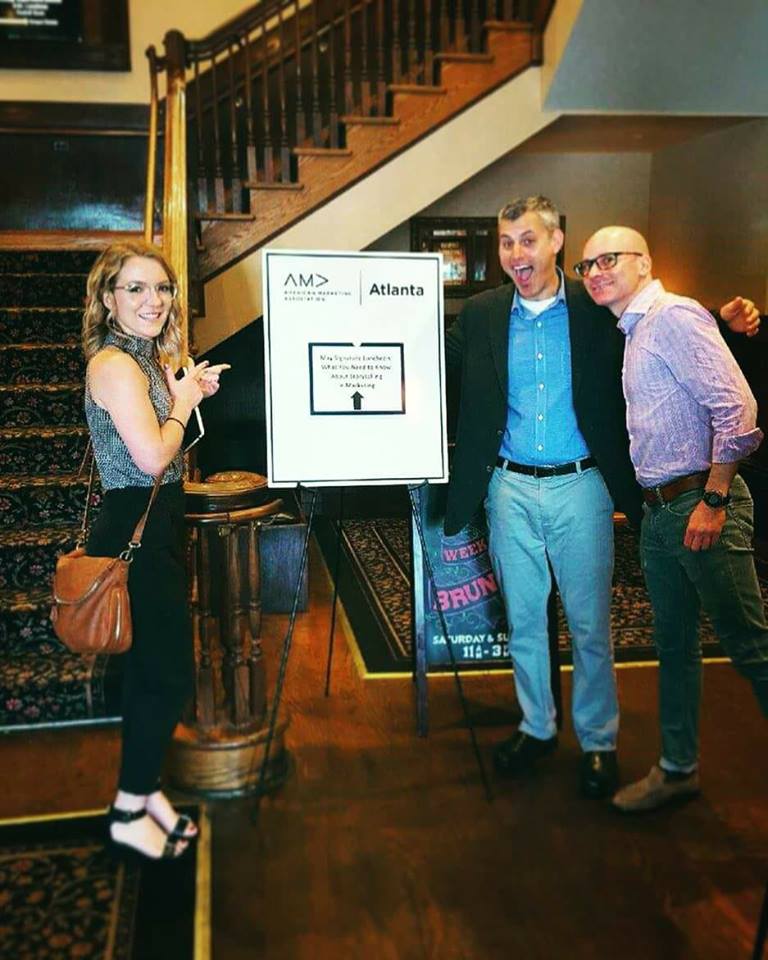Marketing Experts Share Storytelling Tips for Brands
The Setup team recently attended the American Marketing Association (AMA Atlanta) luncheon on the art and importance of storytelling in marketing. One of the biggest challenges to marketers is being memorable in the consumer’s eye and setting their brand apart from their competitors.
Think about car commercials. How many of them take place in a waterfall or mountainous terrain? What makes certain brands memorable? What types of commercials or advertisements stick out?
The AgencySparks team at the American Marketing Association (AMA Atlanta) luncheon on the art and importance of storytelling in marketing.
The presentation started with the panel citing statistics that show the consumers’ average retention rate for something they hear is 5-10%. Consumers recall an image 25% of the time. When consumers hear a story, however, they remember the story 65-70% of the time. Humans are narrative-based. Stories are a perfect strategy for marketers to connect their brand to the consumer’s lifestyle so that they are memorable.
AMA Atlanta hosted two panels featuring marketing leaders from established brands and agencies in Atlanta, Georgia to share their experiences and thoughts on storytelling. Of the speakers, two of them are agency partners with Setup.
Moira Vetter, CEO of Modo Modo Agency
Mike Popowski, CEO of Dagger
Three main themes marketers should implement emerged from the discussion:
Establishing an Authentic Connection
Caring About the Community
Utilizing Emerging Technologies
Establishing an Authentic Connection
According to a study conducted by Stackla, 86% of people will like and choose a brand when the brand is more “organic” and “authentic.” Even though marketing, the art of cleverly displaying a product and catering a message to a consumer in order to close sales, is not “authentic” in nature, brands must find a way to be relatable and honest with the consumer.
Brands can do this by relating to their audience through storytelling. The panel harped on how authentic connections and personalization is the key to winning over the audience.
Jo Ann Herold, the Chief Marketing Officer (CMO) for HoneyBaked Ham, talked about Kelly Baked Ham - a campaign featuring character who represents HoneyBaked Ham’s average consumer in a relatable and humorous light.
The panelists were in agreement that the brand’s marketing should highlight the consumer’s story. Jana Ferguson, the Chief Client Officer at DRUM Agency, emphasized that the "consumerization of things is the most powerful movement in advertising." Brands need to “get out of the way” and highlight the consumer in order to create a meaningful and authentic connection.
Brands can create authenticity by showing that they care about the community.
Jeff Hilimire, the CEO of Dragon Army, spoke about the new app. his agency built for Liz Ward, the CMO of the United Way of Greater Atlanta called Volunhere. People have a natural inclination to “do good, now we give them an outlet to find volunteering” opportunities in their area, track their involvement, and share their good deeds with friends.” Sharing the good deeds enhances the volunteer’s reputation, exposes the need for volunteers in the area, and is good word of mouth for the organization.
Whether their motivation is about personal gratification or to make a difference, Volunhere enables people to “do good.”
Utilizing Emerging Tech
Technology will continue to advance so marketers must constantly re-adjust.
When measuring the Return of Investment (ROI) and what is and is not working, look at the strategy from the customer’s perspective. If the campaign is not driving a sale, then the story is not resonating with the consumer. Tell a different story. Jana Ferguson advised to start with sequential marketing. Break down silos and use results to analyze what strikes a chord.
More technology means more data access. Truly utilize every piece of data to influence the brand’s storytelling.
Mike Popowski, CEO of Dagger Agency used Netflix and Spotify as examples of brands who use data to tell their story and adjust to the consumer’s needs.
Spotify has had multiple campaigns where the brand leveraged date to share specific stories that brings the Spotify brand to life for their audience. The approach is true to the brand’s voice and style and catches the consumer’s attention with it’s authenticity and hilarity.
Netflix has algorithms that will make suggestions or change image selections based on the consumer’s watching behavior. Netflix also uses the consumer watching behavior to craft their original movies and TV shows - giving the consumer their desired programming preferences and an ideal user experience. Netflix’s smart use of data to influence programming is leading to it’s massive takeover over other streaming services and cable networks.
Evolving their Approach to Marketing
The manner in which customers consume content will constantly change. Storytelling has evolved from pictures, to word of mouth, to writing, to video. The emotional connection from stories, however, is what sets humans apart from other species. Marketers must remember to rely on this. Alex Gonzalez, the CEO of Highwire, emphasized that technology will enhance and deliver marketers’ message, but it should not replace human connection.
Marketing will also constantly change. Whether it is because of technology, the evolution of media, or consumer preference, marketers need to be open to evolving their brand messaging to cater to the consumer. Though data is important and should drive campaigns, it is vital to look beyond the numbers.
Stories are the unifying force between people. They connect us and help us to relate to one another. Mike Popowski stated that, “Stories are social currency and are passed along because they carry a high degree of emotion and marketers need to harness that power when telling their brand’s story.”











Over the past year, we’ve watched the following patterns emerge across seemingly unrelated sectors: rising consumer expectations, demand for authenticity, growing complexity, and the tension between automation and human connection.
We interviewed multiple marketers from an array of industries in our blogs below, and we discovered consistent trends across the board. Check out all of our industry blogs throughout 2025 from leaders at Blackbaud, Hiscox USA, Mimedx, MONPURE, Kimberly-Clark Professional, and more.